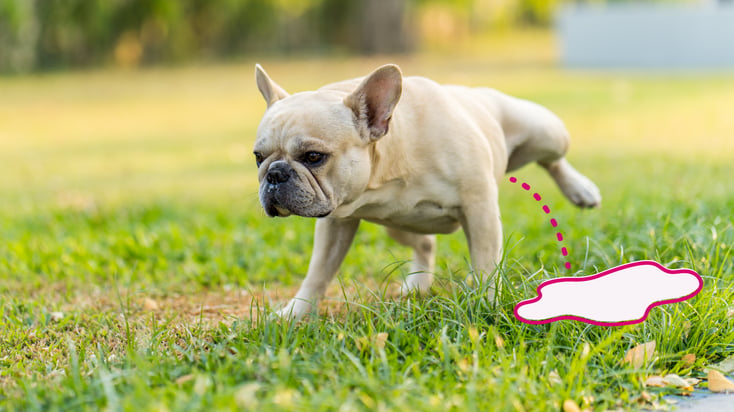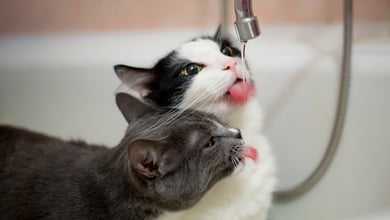Why is My Dog Peeing so Much? 11 Possible Causes

Table of Contents
Each dog is unique, and this individuality extends to their bathroom habits too! But what do you do if your dog suddenly needs to urinate more than usual, urinating eight or even ten times a day instead of their usual three to five?
As a pet parent, it's essential for you to understand the underlying reasons for excessive urination in dogs, so you can spot the signs and get prompt diagnosis and treatment for your pet.
Here are the most common reasons for excessive urination in dogs:
1. Age
Puppies urinate more frequently than adult dogs because they drink water more often, and their bladders are smaller. Generally, puppies can hold urine for the hours equivalent to their age in months.
Adult dogs tend to urinate every four to eight hours depending on their breed and size, while senior dogs urinate more frequently.
2. Excessive Drinking of Water
Your dog may drink lots of water when the weather is hot or after strenuous exercise. However, prolonged high water intake could signify a medical issue, so you should consult your veterinarian for a proper analysis of the situation.
How Much Water Should My Dog Drink in a Day?
How Much Water Should My Dog Drink in a Day?
View Results
How Much Water Should My Dog Drink in a Day?
Based on your pet’s weight and energy level, your dog should be drinking approximately ounces of water per day
On hot days, expect your dog to need more water. Adult dogs will generally drink when thirsty, so make sure to provide lots of cool, fresh water for them. Puppies and senior dogs may need to be reminded to keep up with their water intake, so if you do not observe them drinking regularly, make sure to lead them to their water bowl and encourage them to drink.
The above calculator is meant to serve as a general guide for your pet. Every dog has their own unique needs, and therefore, we recommend that you speak to your veterinarian if you have concerns about your pet’s nutrition, including how much your dog should be drinking each day.
Share Quiz
3. Electrolyte Imbalances
Electrolyte imbalances, especially those involving sodium or salt, can lead to excessive thirst and increased urination in dogs. These imbalances may arise from high-sodium meals, dehydration, toxins, or other medical issues. It's essential to avoid giving pets high-sodium foods and ensure they always have fresh water available.
If you're concerned about persistent symptoms or your pet's water intake, it's best to consult a veterinarian. They can offer advice, conduct necessary tests, and recommend appropriate treatments.
4. Behavioral Issues
If you see your dog urinating a lot during walks or when visiting new locations, it could be marking territories.
Unspayed female dogs will urinate frequently when coming into heat. Other behavioral reasons for increased urination include anxiety or significant shifts in their living environment or routines.
Addressing such behavioral issues can sometimes require a deeper understanding of canine behavior.
Concerned About Your Pet's Unusual Behavior?
Get peace of mind with expert counseling. Identify the reasons behind common behavior challenges and nurture a fulfilling bond with your beloved pet.
5. Urinary Tract Infection (UTI)
Urinary tract infections are fairly common in dogs, especially in females. They are often referred to as bladder infections and occur when bacteria from the external environment, such as E. coli, enter the bladder.
The most common symptoms of urinary tract infections include frequent, small amounts of urination, and straining to urinate. If you notice your dog suddenly urinating frequently, a UTI could be the culprit.
6. Medication Side Effects
Certain medications, such as corticosteroids, diuretics, and anticonvulsants, may cause increased thirst and urination in dogs. It is essential to inform your veterinarian if your dog is urinating a lot when taking such drugs.
Your veterinarian may adjust the doses or make further recommendations to alleviate the problem.
7. Spaying and Neutering Effects
Hormonal-responsive incontinence, also called urethral sphincter mechanism incompetence (USMI), occurs due to a decrease in the hormone estrogen, affecting bladder storage capacity and sensitivity of the sphincter muscles. It commonly affects spayed female dogs, and can lead to urinary incontinence.
8. Bladder Stones
Bladder stones are rock-like mineral formations in the urinary bladder. They are distinct from bladder infections and are characterized by bloody urine (hematuria) and difficulty urinating (dysuria). Your dog will experience frequent urination and pass small amounts every time.
Diagnosis of bladder stones is done via X-rays, ultrasound examination, or radiographic contrast study. There are three treatment options depending on the makeup of the stone: surgical removal, urohydropropulsion, and dietary dissolution.
9. Cushing's Disease
Also known as hyperadrenocorticism or Cushing's disease, the condition results from the overproduction of the hormone cortisol. Excess cortisol weakens your dog's immune system, predisposing them to other diseases and infections.
Cushing's disease is characterized by increased thirst, increased urination, and elevated appetite among other symptoms.
Diagnosis requires blood tests and ultrasounds, and treatment involves management with medications.
Quick and Easy In-Home Lab Work for Your Pet
With in-home diagnostic testing, your fur baby can stay comfortable while we perform any necessary blood work.
10. Canine Diabetes
Diabetes mellitus is the most common type of diabetes in dogs. It is the underproduction of insulin or the inability of your dog's body to respond to insulin. Canine diabetes causes excessive thirst and increased urination.
Treatment and management involve insulin therapy, periodic blood testing, and monitoring.
1. Has your dog experienced rapid weight loss?
2. Has your dog’s appetite increased or decreased?
3. Is your dog more thirsty than usual?
4. Is your dog urinating more frequently than usual?
5. Is your dog less active than usual?
6. Does your dog have cloudy eyes or is experiencing vision problems?
7. Is your dog experiencing frequent urinary tract infections?
8. Does your dog have sweet-smelling breath?
9. Does your dog seem more lethargic than usual?
10. Does your dog have a family history of diabetes?
11. Is your dog's coat dull or thinning?
12. Has your dog had frequent skin infections?
1. Is your cat urinating more frequently than usual?
2. Is your cat more thirsty than usual?
3. Has your cat experienced rapid weight loss?
4. Is your cat showing signs of muscle weakness?
5. Has your cat’s appetite increased or decreased?
6. Does your cat seem more lethargic than usual?
7. Is your cat vomiting more than usual?
View Results
11. Kidney or Liver Disease
Kidney disease hampers the kidneys' ability to efficiently filter waste products from the blood. This results in excessive urination.
Excessive urination and thirst can also result from liver disease. Diagnosis involves various blood tests, X-rays, ultrasonography, and aspiration or biopsy procedures.
Early treatment is critical if your dog is suffering from kidney failure or liver disease.
What Should I Do if My Dog Is Peeing Excessively?
Frequent urination in dogs can be an indicator of underlying medical conditions. Consult your veterinarian immediately if your dog is urinating a lot and has the following signs:
- Blood in the urine
- Straining to urinate or producing no urine
- Urinary accidents
- Discolored urine
- Vomiting
- Loss of appetite
- Lethargy
Conclusion
After potty training, young puppies develop urination habits that they follow throughout their lives. Paying attention to your dog's urination habits can help you detect any anomalies and seek professional advice in time.
It can be heartbreaking to see your senior dog urinating frequently, and taking them to a pet hospital can be challenging. To spare you the transportation challenges and avoid disrupting your long-time companion's comfort, you can book a home vet visit.
Is Your Pet Feeling Under the Weather?
Get the care your pet needs without leaving home. We have same-day appointments in most locations when it can’t wait.
Frequently Asked Questions
What is excessive urination in dogs?
Increased urination in dogs is characterized by frequent urination, accidents, or incontinence. Your dog may excrete large volumes of urine (polyuria) or release small amounts more frequently than normal (pollakiuria).
How much is too much peeing for a dog?
Generally, puppies should be able to hold their urine for at least two hours, while adult and young dogs hold it for at least four to six hours. If your pet always needs to urinate more often than that, it could be a sign of a problem.
Should I be worried if my dog is peeing a lot?
Excessive urination in dogs can indicate medical issues, so you should have your veterinarian examine them within 24 to 48 hours, sooner if straining or blood in the urine is seen.
Which dog breeds are more prone to frequent urination?
No dog breeds are specifically more prone to frequent urination. This can affect any dog due to the wide range of potential causes.
Are there ways to prevent frequent urination in dogs?
You can prevent frequent urination in your dog by seeking prompt treatment for underlying causes, following a prescription diet (if warranted), and making lifestyle changes. Do not attempt to reduce your dog's water intake to reduce their urination, unless specifically instructed to by your veterinarian.






